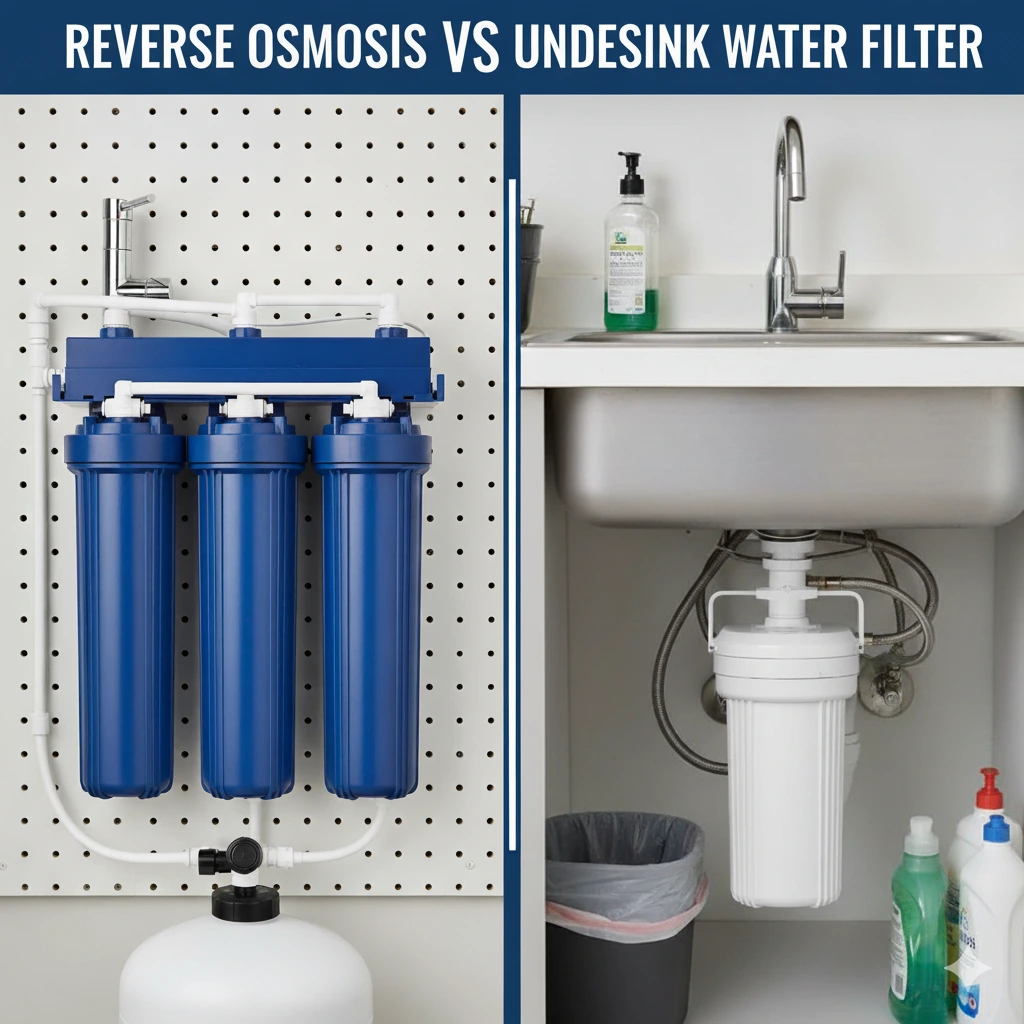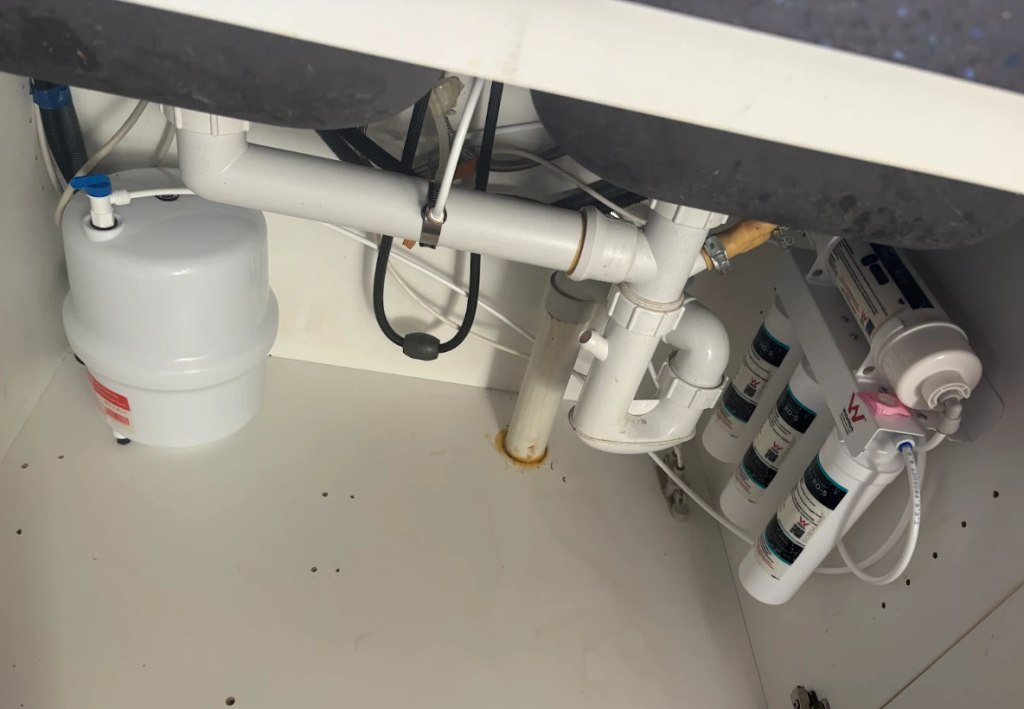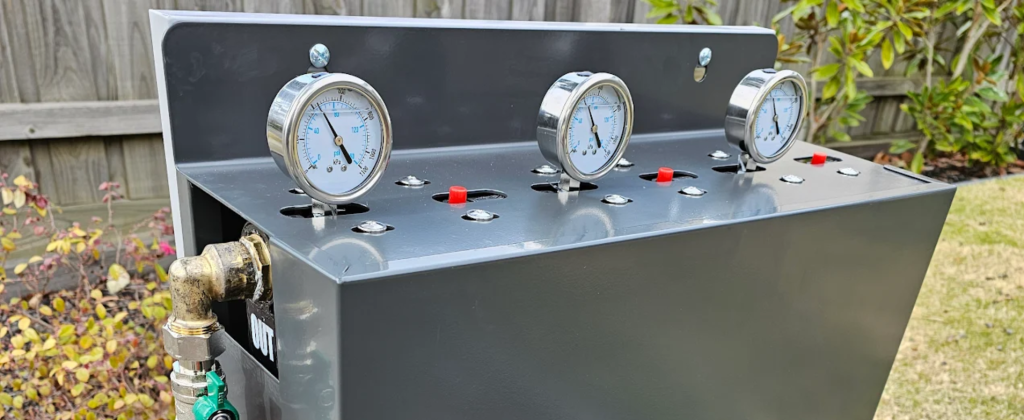Table of Contents

INTRODUCTION:
Today, we compare a reverse osmosis vs undersink water filter. In this blog, I will explain so you can decide which one works better for your household. Every household requires clean and safe filtered water; therefore, selecting the perfect system will have an impact on your overall health and the quality of water used in your home.
In Australia, the quality of tap water often differs according to location, and you will need to filter the water system that is preferably suited for your area. With hundreds of options to choose from, two of the most common choices are reverse osmosis water filters and undersink water filters. In this, we will see how these two types of filters work, their advantages and drawbacks, as well as the major differences between them, to help you choose better.
What is a Reverse Osmosis Water Filter?
A reverse osmosis water filter is a sophisticated system that cleans water by passing it through a semipermeable membrane and eliminating impurities, including microscopic particles, as well as dissolved salts and other potentially harmful microbes. The science of the reverse osmosis (RO) system is that it forces water, under pressure, through a semi-permeable membrane, leaving behind all the goop and crap.
How Does a Reverse Osmosis Filter Work?
How does reverse osmosis work? Starting with several pre-filters that help to stage out larger contaminants. The water then comes through the semipermeable membrane stage, which is the core of it all. The membrane filters dissolved solids, as well as the chemicals that form them (heavy metals, etc.), pesticides, fluoride, and chlorine, but cannot filter microorganisms such as bacteria or viruses.
RO systems operate by pressurizing water to push it through the membrane. This is essentially reversing the natural osmosis process, which sees water move from a lower concentration to a higher concentration. The purified water, having passed through the membrane, is stored in a clean water storage tank for use. The filtered pollutants are usually removed in the form of wastewater.
RO is known to eliminate as high as 99% of the contamination from water, which makes it efficient when it comes to purifying water on a purity grade scale.
Advantages of Reverse Osmosis Water Filters
Superior Contaminant Removal:
One reason that reverse osmosis water filters are so popular is that they can filter out such a wide range of pollutants. A reverse osmosis system is capable of efficiently filtering out a variety of contaminants that cannot be removed by other filtration systems, such as heavy metals (lead and mercury), pesticides, chlorine, fluoride, bacteria, and viruses. If you worry about what is actually in your water, then a reverse osmosis filter is the option for you.
Example: For those living in a place where there’s a risk of lead contamination in the water supply (say, for instance, if you live in an older home with pipes that contain lead), a reverse osmosis water filter can offer peace of mind by removing lead particles that are damaging to health, especially for children.
Improved Taste and Odor:
And because reverse osmosis filters out chemicals such as chlorine and chloramines, the resulting water tastes and smells better. For many, moving to reverse osmosis water filters means that they are much happier with the taste of the water that comes out of their tap, since chlorine and other chemicals can give the water a bad aftertaste.
Example: If you live in an Australian suburb with high levels of water chlorination, you might be tasting something like a strong chemical in your tap water. An RO system can significantly decrease that taste or even remove it altogether, making your water fresh and clean to drink.
Convenience of Continuous Supply:
With an RO system, especially one that is mounted under your kitchen counter, this becomes gross, purified water right from your tap. Which is you will not have to lug around bottled water or fill up the kettle and wait for your water to boil. The system is installed directly into your plumbing, giving you a virtually endless supply of clean drinking water.
Example: If you’re throwing a family BBQ for friends, an RO water filter means that you’ll never run out of clean filtered drinking water (unless someone forgets to fill up the pitcher), and you don’t have to worry about buying and storing bottles.
Disadvantages of Reverse Osmosis Water Filters
Water Wastage:
One drawback of reverse osmosis water filters is that they actually waste water. An RO system may discard as much as 3 or 4 liters for every liter of product water. This inefficiency is worth considering, especially if you live in an area with little water or if the idea of being wasteful makes you a bit twitchy.
Example: If you live in a dry part of Australia, where water is scarce, then an RO system may not be ideal for your home due to its wasteful nature.
Removal of Beneficial Minerals:
In addition to eliminating dangerous contaminants, reverse osmosis systems also strip the water of vital minerals like calcium and magnesium. Soil components such as these minerals are beneficial to human health, and some individuals desire them in their drinking water.
Example: If you are one of those people who look to water as a source of important minerals, reverse osmosis water filters might not be the best solution for you unless they include a remineralization filter that adds everything your body needs back to the liquid.
Higher Initial Cost:
Whole house reverse osmosis systems are usually more costly initially than other types of filtration systems. The cost of upkeep, such as changing filters and system checks, can also be higher in the long term. The upfront cost, however, could be prohibitive for budget-tight wads.
Example: If you live in a compact apartment in Melbourne or Sydney, and need a cost-effective filtration solution, it’s easy to be put off by the higher initial investment of an RO system when another type of water filter could be suitable for smaller needs.
What is an Undersink Water Filter?

An undersink water filter is a filtration system that you hook up directly to your plumbing and place underneath the kitchen sink. Unlike reverse osmosis, undersink filters usually contain activated carbon, ceramic filters, or other types of material to filter out impurities.
These are lower-overhead filters than RO systems, and tend to be more affordable. Undersink filters also don’t need a bulky water storage tank, so they generally produce less waste. Under-the-sink filters are best for those who’d like to get better-tasting and better-quality water straight from their tap without a more tasteless, even overpriced, filtration system.
How Does an Undersink Water Filter Work?
How do Undersink Water Filters Work? The most popular type of filtration is activated carbon filters, which adsorb impurities like chlorine, volatile organic compounds (VOCs), and sediment. Other systems may have a variety of stages, such as sediment filters, carbon block filters, and even UV treatment to address a wider scope of contaminants.
Unlike reverse osmosis systems, which use pressure to push water through a membrane, undersink filters work off gravity or simple flow filtration. The water gets pumped through the filter media and comes out of a filtered water faucet that is mounted on your sink.
An undersink filter is easy to install, so most homeowners can do the installation themselves without having to hire a pro. It is then, in this type of filter system, necessary to regularly perform maintenance and replace filters in order to keep the system working effectively.
Advantages of Undersink Water Filters
Cost-Effective and Low Maintenance:
That lower upfront cost compared with reverse osmosis systems is one of the biggest reasons undersink water filters are so common. There are far simpler and less expensive systems that can be installed, which is ideal for those who do not have much to spend. Filter replacement is also less expensive, as the filters are only required to be replaced once or twice a year.
Example: If you reside in a part of Australia where the tap water is generally safe, but you would just like to get rid of chlorine or sediments, an undersink model may be perfect. It delivers clean water without the high cost of a reverse osmosis system.
Mineral Retention:
Undersink filters, unlike reverse osmosis systems, don’t eliminate beneficial minerals like calcium and magnesium. This is a positive for those who prefer to keep natural minerals in their water, since those minerals can be good for bone health and overall wellness.
Example: If you are concerned about your calcium intake and want your water to retain healthy minerals, an undersink filter might be a better fit for you than an RO system (which removes those helpful compounds from the water).
Quick and Easy Installation:
Compared with reverse osmosis systems, undersink filters are also generally much easier to install. And many of them don’t require professional installation. They can often be installed by homeowners who connect the filter to the cold water connection beneath the sink.
Example: In case you’re renting a property in Australia and want a quick, temporary undersink water filter for good quality water, the undersink one is very convenient because it installs and uninstalls with ease, and does not damage any plumbing system.
Disadvantages of Undersink Water Filters
Limited Contaminant Removal:
Undersink water filters remove chlorine, sediment, and some heavy metals, but lack the same level of purification you get with reverse osmosis. They won’t be able to remove dissolved salts, fluoride, or some other microorganisms.
Example: If you live in a high-rise apartment in inner Sydney, where tap water is contaminated with heavy metals or other impurities, an RO filtration system might be more suitable than an undersink one.
Filter Replacement Frequency:
No maintenance: Undersink system doesn’t require regular care, other than replacing the 3 pre-filters and post-filter. You may have to change the filter every half a year to once a year; it all depends on what type of filter you are using. This can contribute to the long-term cost, particularly if you use the filter often.
Example: If you have a big family and use lots of water, your filters may need to be replaced more often, which could drive the maintenance costs up.
Reverse Osmosis Water Filter vs Undersink Water Filter: Key Differences in Filtration Method
The method of filtration is one of the major distinguishing factors when it comes to a reverse osmosis water filter vs an undersink water filter. Both systems are intended to enhance water quality, though in different fashions.
How Reverse Osmosis Filters Work:
A reverse osmosis water filter functions by means of pressuring the water through a semi-permeable membrane using high pressure. The membrane eliminates particles as small as ions, dissolved solids, and chemicals. This is what makes it so much more efficient at removing toxic materials like lead, fluoride, chlorine, pesticides, and other harmful compounds, such as bacteria (and some viruses). Beyond the membrane, the water is clean and clear, and the contaminants are sent down the drain as waste.
How Undersink Water Filters Work:
Other filters, such as undersink filters, typically require multiple levels of filtration stages that may involve activated carbon filters, sediment filters, and even UV and ceramic filtration at times. These filters eliminate bigger particles such as sediment and chlorine, and also reduce bad taste and odors. But usually they won’t remove dissolved solids, heavy metals, or bacteria, as well as reverse osmosis systems. People who are interested in enhancing their water quality and taste, but do not need to address deadly contamination rates, will find them more helpful.
Which One is Better for the Environment: Reverse Osmosis vs Undersink Water Filters?
When comparing the environmental impact of water filters, you will also need to consider undersink or reverse osmosis water filters.
Reverse Osmosis Systems and Water Wastage:

One of the downsides to reverse osmosis systems is that they waste a lot of water. For each liter of clean water obtained, an RO system can result waste of 3 to 4 liters of water. This is wasteful and can be particularly troubling in regions that depend on water conservation, such as dry climates or those with limited water supply.
Efficiency in Water of Undersink Filters:
Undersink water filters, on the other hand, are better for the environment because they don’t waste water. They just filter the water that moves through your system and pours from your tap, without all the excess water waste that happens with reverse osmosis systems.
If you value green living and water preservation, then you’re better served with undersink filters. They also offer an eco-friendly way to filter your water that doesn’t waste thousands of gallons of water being purified.
Maintenance Costs and Filter Lifespan: Reverse Osmosis vs Undersink Water Filter
When it comes to long-term costs, there are maintenance costs and filter life spans for both reverse osmosis systems and undersink water filters that need to be considered.
Filter Replacement and Maintenance for Reverse Osmosis Systems:
RO system needs regular maintenance and filter changes to work efficiently. The pre-filters are due to be replaced every 6-12 months, and the RO membrane may need changing every 2-3 years, depending on usage and water quality. There is also the cost of maintaining such a system, since there may be a need for regular checks on its functionality.
Filter Replacement and Maintenance for Undersink Filters:
Undersink filters, on the other hand, tend to be more of a set-it-and-forget-it situation with less ongoing maintenance and lower-cost replacement parts. The activated carbon filters may require replacement every 6 to 12 months, and the other filtration media can last longer. As undersink filters are not as intricate as RO systems, they generally end up being less costly to maintain.
If you’re on a tight budget or if you want something less, undersink filters might be more cost-effective in the long run.
Conclusion: Reverse Osmosis vs Undersink Water Filter – Which is Best for Your Home
Whether to get a reverse osmosis water filter or an undersink water filter depends on your preferences, budget, and how concerned you are about the quality of your tap’s water.
- Option for a Reverse Osmosis Filter, if you require the most comprehensive purification and are worried about contaminants such as heavy metals, chemicals, bacteria, and viruses. If you have really contaminated water or know the water at your place is terrible, reverse osmosis systems are the best.
- Option for an Undersink Filter, if you’re interested in a budget option and want to lessen your impact on the environment, while also reducing maintenance needs for better-tasting and better-quality water. These are convenient for general filtration of water, eliminating chlorine, sediment, and taste, but they don’t always offer the same level of filtering you get with a reverse osmosis system.
In the end, each type of filter has its own benefits. Whether you have a concern about water quality and treatment, the needs of the environment, or upkeep costs, there is a solution that meets your need for clear water in and safe water out.
_edited_9.png)